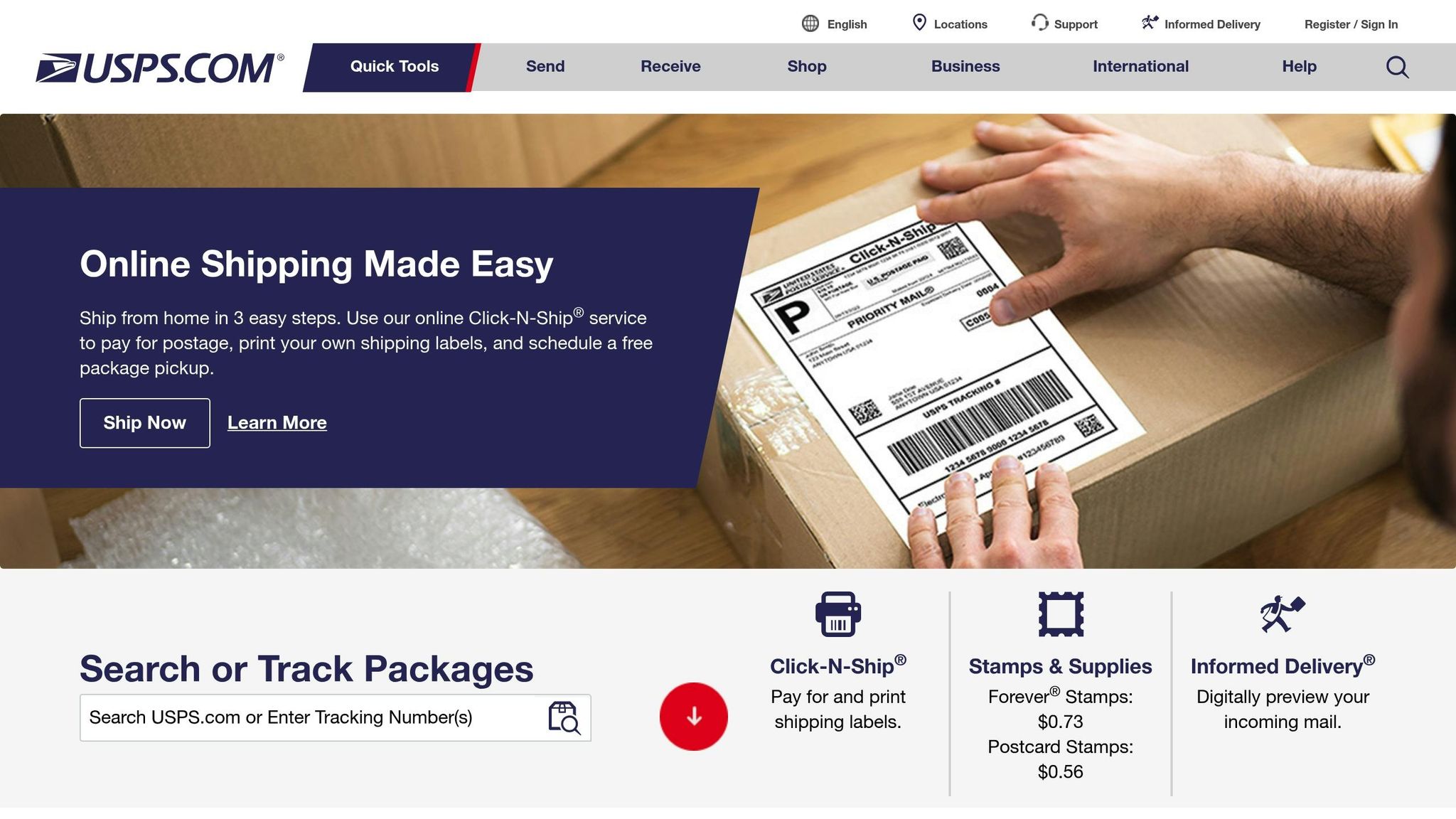Shipping in 2025 is all about balancing cost, speed, and reliability. Here’s what you need to know:
- USPS is the cheapest for lightweight packages under 10 lbs, starting at $7.65 for a 1 lb package.
- UPS offers the best rates for heavy packages (20+ lbs), with ground shipping for a 30 lb package costing $23.50.
- FedEx leads in expedited shipping, with competitive 2-day rates starting at $22.50 for a 1 lb package.
Quick Comparison
| Carrier | Best For | Starting Rate |
|---|---|---|
| USPS | Lightweight packages, residential delivery | $7.65 (1 lb Ground) |
| UPS | Heavy packages, reliable tracking | $8.10 (1 lb Ground) |
| FedEx | Expedited shipping | $22.50 (2-Day, 1 lb) |
Key changes in 2025:
- UPS and FedEx increased rates by 5.9%, while USPS raised Priority Mail by 6.3%.
- New surcharges like UPS’s $10 paper invoice fee and FedEx’s 28.2% increase in handling surcharges.
- USPS remains surcharge-free for residential and remote deliveries.
For cost savings, consider multi-carrier strategies, optimize packaging to reduce dimensional weight, and negotiate discounts based on shipping volume.
The Cheapest Way To Ship A Package – USPS Vs FedEx Vs UPS

2025 Rate Changes by Carrier
The shipping industry in 2025 is seeing notable rate adjustments across major carriers. Each provider has introduced specific changes impacting everything from base rates to additional fees and surcharges.
UPS Rate Changes
UPS has rolled out several updates for 2025, including new fees and revised payment terms. Here's a breakdown of the key changes:
- Payment Processing Fee: Starting May 19, 2025, a 2% fee will apply to invoices.
- Late Payment Fee: Increasing from 8% to 9.9%, effective March 31, 2025.
- Paper Commercial Invoice Surcharge: $10.00 per non-digital shipment.
- Print Invoice Fee: $5.00 per printed copy.
- Payment Fee (check/wire): $25.00 per transaction.
- International Collect on Delivery (ICOD): $12.00.
"One reason UPS may have earmarked these payment fees for increase versus shipping rates is the blind-spot they generally inhabit for most shippers when comparing carriers".
These adjustments suggest a focus on administrative charges rather than shipping rates, prompting shippers to reassess their invoicing and payment methods.
USPS Price Updates
Starting July 13, 2025, USPS will introduce rate increases across several service categories:
| Service Category | Rate Increase |
|---|---|
| Priority Mail | 6.3% |
| USPS Ground Advantage | 7.1% |
| Parcel Select | 7.6% |
| First-Class Mail Forever Stamp | $0.78 (up from $0.73) |
| Certified Mail | $5.30 (up from $4.85) |
USPS has opted to keep rates for Priority Mail Express and International Products unchanged, maintaining competitive options for lightweight packages. This approach aligns with current market trends, ensuring affordability in specific areas while adjusting others.
FedEx Price Changes
FedEx has also revised its pricing structure to stay competitive, with changes effective January 6, 2025. Here's what to expect:
- Average Rate Increase: 5.9% for package and freight standard list rates across U.S. domestic, export, and import services.
- Base Customs Brokerage Rates: Increased by 4%.
- Late Payment Fee: Adjusted to 9.9% starting June 1, 2025.
- Additional Handling Surcharges: Year-over-year increase of 25.9% to 28.2%.
"Overall, these changes will require businesses to carefully evaluate their shipping strategies, particularly those dealing with heavier packages, residential deliveries, and rural destinations".
FedEx appears to be discouraging the use of its Express network for heavier or long-distance shipments by raising rates in select zones and weight categories. This strategy nudges shippers toward more economical Ground services for certain types of deliveries.
Each carrier's adjustments reflect shifting priorities and strategies, making it essential for businesses to review their shipping plans for the year ahead.
Package Size and Weight Costs
When it comes to shipping costs, package size and weight play a huge role in determining the best carrier for the job. Below is a breakdown of how UPS, USPS, and FedEx compare across different weight categories in 2025.
Light Packages (1-5 lbs)
For packages on the lighter side, USPS consistently offers the lowest rates. Here's a closer look at ground shipping costs for this weight range:
| Weight | USPS Ground Advantage | UPS Ground | FedEx Ground |
|---|---|---|---|
| 1 lb | $7.65 | $8.10 | $8.75 |
| 5 lbs | $9.90 | $10.20 | $11.50 |
As packages get heavier, you'll notice shifts in pricing trends among the carriers.
Mid-Size Packages (5-20 lbs)
For medium-weight shipments, the pricing starts to even out across carriers. Here's how they compare:
| Weight | USPS Ground Advantage | UPS Ground | FedEx Ground |
|---|---|---|---|
| 10 lbs | $12.20 | $13.40 | $14.75 |
| 20 lbs | $16.35 | $17.80 | $19.20 |
If you're looking at express shipping for mid-size packages, FedEx often stands out with competitive rates. For example, a 10-pound package shipped via 2-day service would cost:
- FedEx 2Day: $50.25
- UPS 2nd Day Air: $52.00
- USPS Priority Mail Express: $57.00
Once the weight exceeds 20 pounds, the cost dynamics shift yet again.
Heavy Packages (20+ lbs)
For heavier shipments, UPS takes the lead with the most affordable rates. For instance, ground shipping a 30-pound package costs:
- UPS Ground: $23.50
- USPS Ground Advantage: $27.50
- FedEx Ground: $28.75
A few additional points to consider with heavy packages:
- Weight Limits: UPS accepts packages up to 150 lbs, while USPS limits packages to 70 lbs.
- FedEx Surcharges: FedEx applies a minimum billable weight of 40 lbs for packages that trigger their Additional Handling Surcharge.
- Overnight Shipping: For a 30-pound package, UPS Next Day Air costs $124.00, whereas FedEx Standard Overnight is priced at $138.50.
Lastly, keep in mind that dimensional weight can significantly affect shipping costs. USPS often uses more favorable calculations for larger, lighter packages compared to UPS and FedEx, which could make a big difference depending on what you're shipping.
Delivery Speed Price Comparison
When it comes to choosing a shipping carrier, delivery speed plays a huge role. Each provider offers different service levels, balancing cost with how quickly packages arrive.
Ground Service Rates
For non-urgent deliveries, ground shipping is the most budget-friendly option. UPS Ground stands out with competitive pricing and reliable transit times, followed closely by USPS and FedEx. If you're looking for detailed rates based on package weight, check out the comparison table in the "Package Size and Weight Costs" section. Notably, USPS often offers better pricing for residential deliveries compared to its competitors.
2-Day Shipping Costs
Need faster delivery? Express 2-day shipping is the next step up. Among the major carriers, FedEx 2Day tends to have the best rates for this service. Here's a quick breakdown:
| Weight | FedEx 2Day | UPS 2nd Day Air | USPS Priority Mail Express |
|---|---|---|---|
| 1 lb | $22.50 | $23.30 | $25.65 |
| 5 lbs | $34.90 | $36.50 | $37.65 |
| 10 lbs | $50.25 | $52.00 | $57.00 |
| 20 lbs | $67.85 | $72.50 | $78.50 |
For even faster options, keep reading about next-day and same-day services.
Next-Day and Same-Day Rates
For those who need packages delivered ASAP, next-day and same-day services are the go-to. UPS offers solid express options, while FedEx is known for its premium, business-oriented services.
Starting rates for a 1-pound package with next-day delivery:
- USPS Priority Mail Express: $31.40
- FedEx Standard Overnight: $38.55
- UPS Next Day Air Saver: $42.42
If early morning delivery is a must:
- FedEx First Overnight guarantees delivery by 8:00 AM, starting at $150.50 for a 1-pound package.
- UPS Next Day Air Early offers similar timing, with rates starting at $160.00.
Be mindful of additional charges for overnight shipping. For instance, USPS applies a $12.50 weekend surcharge, while FedEx fees range from $6.20 to $77.50 depending on the destination. Dangerous goods? That’s a hefty $175 surcharge with FedEx.
When deciding on a carrier for expedited shipping, it’s crucial to factor in both the base rates and any extra fees tied to delivery location, package type, and timing needs.
sbb-itb-fd652cc
Extra Fees and Surcharges
Shipping costs can quickly add up due to various fees imposed by carriers. Let’s break down some of the key surcharges that impact the final price.
Home Delivery Fees
Both UPS and FedEx tack on additional charges for residential deliveries, while USPS does not. Here's how they compare:
| Carrier | Residential Delivery Surcharge |
|---|---|
| USPS | $0.00 |
| FedEx | $6.20 |
| UPS | $6.15 |
These fees are particularly relevant for businesses shipping to residential addresses.
Remote Area Fees
Delivering to remote areas comes with its own set of challenges, and carriers often charge extra for these locations. USPS stands out by offering remote delivery without any additional fees, while UPS and FedEx apply surcharges to a significant portion - about 62% - of ZIP codes in the U.S..
Here are the remote area charges for 2025:
- UPS: $15.35
- FedEx: $15.50
- USPS: $0.00
For example, shipping a 3-pound package from Chicago to Bethel, Alaska demonstrates the cost disparity:
- FedEx: $170.51
- UPS: $160.43
- USPS Priority Mail: $23.95
This highlights how USPS can be a more affordable option for remote deliveries, especially to locations like Alaska or Hawaii.
Fuel Charges
Fuel surcharges are another factor to consider, as they fluctuate weekly based on national fuel prices. As of May 19, 2025, FedEx fuel rates were:
- Ground and Home Delivery: 17.75%
- Express Services: 16.50%
- Export Services: 21.25%
- Import Services: 25.00%
"A recent Wells Fargo analysis indicates that USPS parcel pricing was approximately 25 percent to 60 percent below FedEx and UPS prices, depending on product type, in the fourth quarter of 2024."
For the latest updates, it’s essential to check carrier websites regularly for current fuel surcharge rates.
With these surcharges in mind, the next step is to explore ways to reduce shipping costs effectively.
Cost-Saving Methods
Shipping often makes up 10–15% of operating costs, but there are smart ways to reduce these expenses without sacrificing service quality.
Multi-Carrier Shipping
Using multiple carriers can cut shipping costs by as much as 40% and improve delivery reliability. Instead of sticking with one provider, you can take advantage of each carrier's strengths and competitive pricing.
Here’s a quick breakdown of what different carriers are best at:
| Carrier | Best For | Starting Rate |
|---|---|---|
| USPS | Small packages, flat rate shipping | $9.65 |
| UPS | Heavy packages (20+ lbs) | $14.25 |
| FedEx | Express/overnight delivery | $15.02 |
By automating rate comparisons, you can ensure you’re always choosing the most cost-effective option for each shipment. For example, one eCommerce retailer adopted a multi-carrier strategy and cut shipping costs by 35% while maintaining a 99.9% on-time delivery rate.
But saving on shipping isn’t just about choosing the right carrier - it’s also about how you package your products.
Package Size Optimization
Dimensional weight (DIM) pricing can significantly impact your shipping costs, especially if your packaging contains unnecessary air or excess materials. On average, boxes are filled with 60–75% air, but with proper optimization, that can be reduced to 30–40%.
Here are some tips to optimize packaging:
- Use the smallest box that safely fits your product
- Switch to poly mailers for non-fragile items
- Invest in custom packaging to eliminate wasted space
- Choose lightweight materials like foam or reinforced cardboard
These adjustments can lead to big savings. For instance, a large eCommerce retailer selling fishing tackle reduced shipping costs by 22% and packaging costs by 10%, saving $2.5 million annually by resizing boxes and improving dimension accuracy.
Once your packaging is optimized, you can save even more by taking advantage of discount programs.
Discount Programs
Negotiating carrier contracts can save you 10–30% compared to standard retail rates. Here’s how to maximize those savings:
- Volume-Based Negotiations: The more you ship, the better your rates. Partner with carriers to secure discounts based on your shipping volume.
- Zone Skipping: Combine shipments heading to the same region to cut costs by 20–35% and potentially reduce transit times by up to 30%.
- Regional Carrier Integration: Using regional carriers for last-mile deliveries can lower costs and improve service. For example, a furniture manufacturer saved 40% on shipping and reduced damage rates by 70% with this approach.
Conclusion: Best Carrier Choice for Your Needs
After reviewing the 2025 shipping rates and services, the right carrier for your shipments depends on your specific needs. Based on the rate and surcharge comparisons above, here’s a quick summary to help guide your decision.
USPS continues to shine for lightweight packages, with analysis from Wells Fargo showing their rates are 25–60% lower than those of FedEx and UPS as of Q4 2024.
Here’s a quick breakdown of carriers by shipping need:
| Package Type | Best Carrier | Why Choose |
|---|---|---|
| Light (1–5 lbs) | USPS | Affordable rates and free pickup service |
| Medium (5–20 lbs) | UPS | Reliable tracking and competitive pricing |
| Heavy (20+ lbs) | UPS | Better value for larger shipments |
| Time-sensitive | FedEx | Strong express delivery network |
For express shipping, FedEx 2Day offers competitive pricing, while UPS Next Day Air is the leader in overnight services. These options align with growing consumer expectations for faster delivery times.
Some key updates that could impact your shipping strategy include:
- USPS anticipates handling 7.5 billion packages in 2025.
- UPS plans to cut its Amazon volume by 50% by mid-2026.
- FedEx has expanded Sunday delivery to reach two-thirds of the U.S. population.
Choosing the right carrier often comes down to matching the service with the package’s size, weight, and urgency. Adopting a multi-carrier strategy - where you select the best carrier for each shipment’s unique needs - along with optimizing packaging and negotiating rates, can help you achieve the ideal mix of cost savings and dependable service.
FAQs
What’s the best way for businesses to use multiple shipping carriers to save money and improve delivery times in 2025?
In 2025, businesses can cut costs and speed up delivery times by embracing a multi-carrier shipping strategy. This means working with multiple shipping providers - like UPS, USPS, and FedEx - depending on what each shipment requires. For instance, USPS might be the go-to for small, lightweight packages, while UPS or FedEx could be better suited for larger or urgent deliveries.
Relying on several carriers instead of just one offers greater flexibility and reliability. Plus, using shipping software can make it easier to compare rates, manage tracking, and improve overall operations. The result? Lower shipping expenses and happier customers thanks to quicker, more dependable delivery options.
What are the key surcharges introduced by UPS and FedEx in 2025, and how might they affect shipping costs?
In 2025, UPS rolled out several new surcharges that could impact shipping costs. Starting April 7, they introduced a 29% fuel surcharge, linked to jet fuel prices. On top of that, the Large Package Surcharge was increased to $205 for commercial shipments and $240 for residential ones. These changes are particularly challenging for businesses shipping bulky items, as they can drive up costs significantly.
FedEx also made adjustments to its fee structure. They introduced a new charge for processing inbound U.S. imports and raised the Additional Handling Surcharge to $38 for packages with specific dimensions. For businesses managing large volumes or oversized shipments, these updates could have a noticeable effect on their shipping budgets.
How can I reduce shipping costs affected by dimensional weight pricing?
To keep shipping costs in check when dealing with dimensional weight pricing, here are some practical tips:
- Pick the right-sized packaging: Avoid oversized boxes by choosing packaging that fits your items snugly, cutting down on wasted space.
- Go for lighter packing materials: Use materials that protect your products without adding unnecessary weight.
- Negotiate with carriers: Some carriers might let you negotiate a higher dimensional weight factor, which can help reduce your expenses.
- Pack efficiently: Arrange items strategically within the box to make the most of the available space and keep the dimensional weight low.
- Consider alternative packaging: For smaller, sturdy items, try poly mailers or padded envelopes to sidestep dimensional weight charges.
It’s worth revisiting your shipping methods regularly to stay in step with carrier policies and pricing updates. Even small tweaks can add up to noticeable savings over time.


